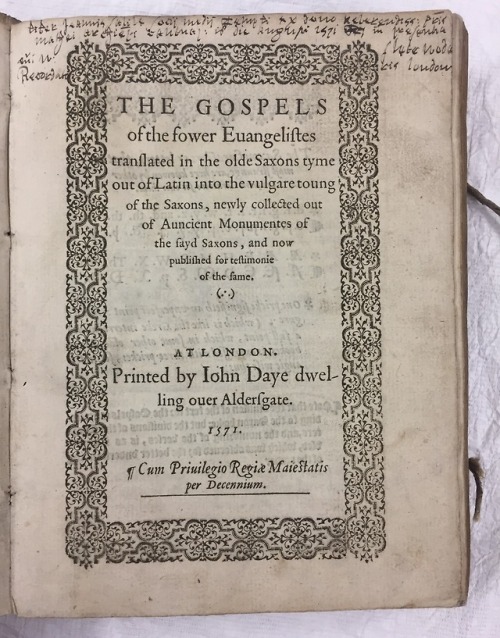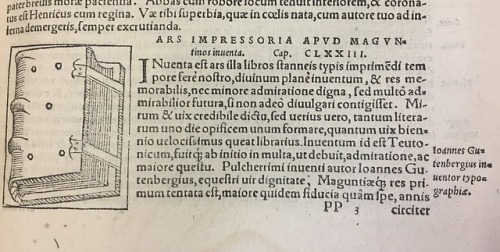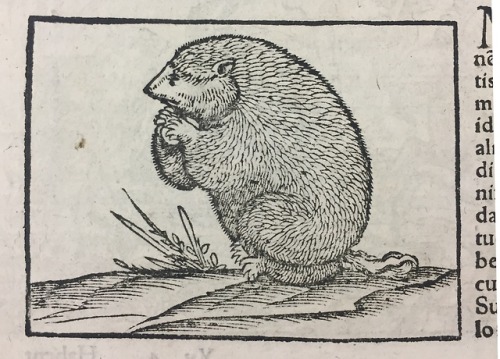#early printing

Protolume chimico e cheggiante di condupplicati paraphrasi (1682) by Giovanni Francesco Aggravi.
This book is part of our Neville Collection which was purchased from Roy G. Neville. This is a first edition Venetian copy, 12mo. 6 leaves, and woodcut printer’s ornament on the title page. It is bound in contemporary vellum with old ink lettering on spine.
Nothing seems to be known of the author, Giovanni Francesco Aggravi (if you know information that might help, let us know! He’s most likely from the 17th century). The first half of this book covers chemical apparatus, operations, and process, with the second half focusing on an alphabetical list of preparations of chemicals, mainly for pharmaceutical uses.
First edition of the Gospels in Anglo-Saxon, with parallel text in English. It is one of four books printed in Anglo-Saxon types by John Daye for Matthew Parker (1504-1575), Archbishop of Canterbury, who in 1574 left his marvellous collection of over 600 medieval manuscripts to Corpus Christi College, Cambridge.
What is notable about the Alexander Turnbull Library copy is the inscription found on the title-page, which notes that this book was presented as a gift by Parker to the lawyer and MP Sir John Savile (1546-1607) of the Middle Temple on 15 August 1571.
The volume was received by the Turnbull Library in 1974 as part of the Sir Arthur Howard bequest.
–
The Gospels of the fower Euangelistes translated in the olde Saxons tyme out of Latin …London: Iohn Daye, 1571, Alexander Turnbull Library, Howard 25.
Post link
Newly Catalogued Incunabula
Earlier this year the Alexander Turnbull Library received a generous bequest from the estate of Mt John Barton, a New Zealand book collector resident in the town of New Plymouth.
Mr Barton (1931-2016) was born on Mersea Island off the coast of Essex, England. Around 1954, his family immigrated to New Zealand and settled in Taranaki. He followed suit two years later, first finding work with the Department of Lands and Survey before being employed as a radiographer at the Taranaki Base Hospital in New Plymouth where he remained until 1978. A few years later he took up employment with Kea Books, a second-hand bookshop located on Devon St. Barton’s bibliophilic mind was well suited to the work. He spent the rest of his working career there and retired as manager in 1991.
The bequest comprised 20 books printed during the 15th and early 16th centuries. Theology is the most prevalent subject, with the earliest publication being a collection of Pseudo-Augustinian tracts (shown here) printed in the town of Lauingen, Germany, in 1472 - one of only two titles printed in Lauingen during the 15th century. It is a remarkable little book typographically, as its roman type is one of the earliest produced in Germany and is unique to this edition.
Cataloguing of the collection is nearing completion and the books will soon be available for study.
Pseudo-Augustine, De anima et spiritu. Add: De ebrietate. De sobrietate. De quattuor virtutibus caritatis. De contritione cordis. [Lauingen: Printer of Augustinus, ‘De consensu evangelistarum’], 9 Nov. 1472, Alexander Turnbull Library, R407716.
Post link
More often than not, when searching for a particular item on the shelf or section of text within a book - in this case, mention of Johannes Gutenberg in Sebastian Munster’s Cosmographia(Basel, 1572 edition) - you stumble upon something unexpected or interesting or both, such as this rather charming woodcut of a slightly nervous looking groundhog.
Sebastian Munster, Cosmographia universalis. Basel: Henricus Petrus, 1572, Alexander Turnbull Library, qRSwiss MUNS Cosm 1572.
Post link






